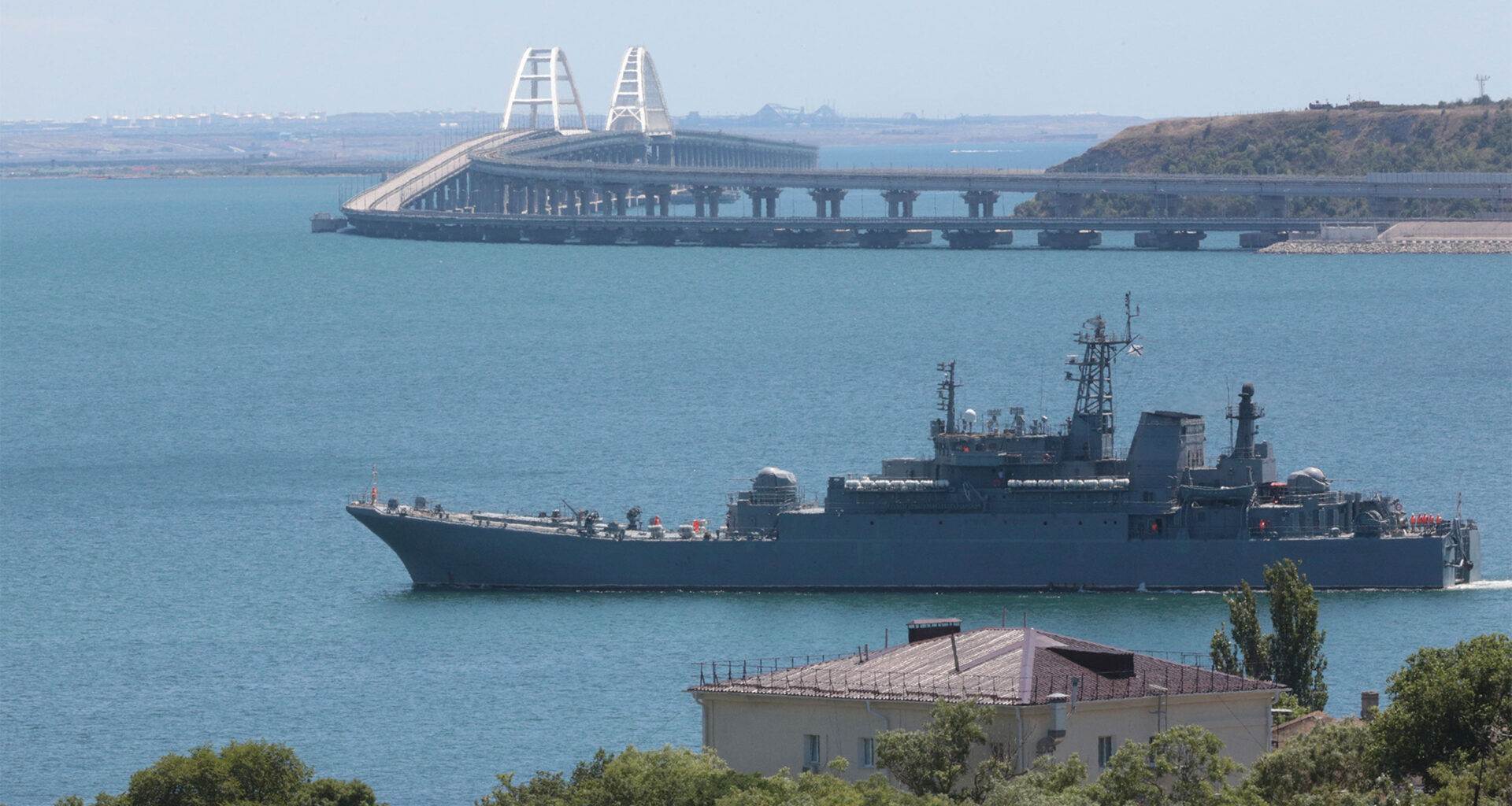The Crimean Peninsula is located in southern Ukraine, jutting out into the Black Sea. Russia’s invasion of Ukraine started there in February 2014, when pro-Russian gunmen seized government buildings and the international airport, ultimately taking control of the peninsula.
Those gunmen were often referred to as “little green men” because they weren’t wearing any identifiable insignia. What became clear was that most of them were Russian soldiers.
In this file photo, Russian troops block the road way towards the military airport at the Black Sea port of Sevastopol in Crimea, Ukraine, Feb. 28, 2014.Andrew Lubimov/AP/File photo
About a month later, Russian President Vladimir Putin illegally annexed the territory, a moment that was celebrated with pomp and circumstance in Moscow.
Inside the gilded halls of the Kremlin, Putin hosted a ceremony where the annexation was signed into Russian law, followed by Kremlin elites chanting “Russia! Russia!” while clapping their hands in unison.
Russian President Vladimir Putin addresses the Federal Assembly in the Kremlin in Moscow, March 18, 2014. Putin added Crimea to the map of Russia, describing the move as correcting past injustice and response to Western encroachment upon Russia’s vital interests.RIA-Novosti, Yekaterina Shtukina, Government Press Service/AP/File photo
For more than a decade, since the start of the invasion, Ukraine and its partners have never recognized Russia’s annexation of Crimea. Now, it is unclear if either Russia or Ukraine will agree to any terms that could lead to a potential ceasefire, especially when it comes to the status of Crimea.
Kimberly St. Julian-Varnon, a PhD candidate in Soviet History at the University of Pennsylvania, explained that for both Russia and Ukraine, Crimea remains culturally and historically significant.
“It is an incredibly important part of Russian imperial history, but also Soviet history,” St. Julian-Varnon said. “It was conquered by the Russian empire in the 18th century, and it was home of the Black Sea naval fleet for the Russian empire and for the Soviet Union.”
Crimea was strategically important from a military perspective, but it was also significant throughout the Soviet Union as a place for healing, leisure and relaxation.
In this photo taken on Oct. 29, 2014, tourists take pictures of Yalta from the Ai-Petri, a peak in the Crimean Mountains.Alexander Zemlianichenko/AP/File photo
“In the Soviet Union, most people could not travel outside the country, so going to Crimea or Sochi, these were the resort towns, the resort areas of the Soviet Union,” St. Julian-Varnon said. “So, I think that’s an important part, regular people get to enjoy this territory.”
People throughout the Soviet Union, including Russians and Ukrainians, felt like they had a direct connection to Crimea. Historically, though, the people Indigenous to Crimea are Crimean Tatars, a Muslim Turkic group, who were repressed and exiled by Joseph Stalin after World War II. As a result, Crimea’s demography became more ethnically Russian.
Local residents hold Ukrainian and Crimean Tatars flags in the village of Chongar, Ukraine, Sept. 20, 2015.Evgeniy Maloletka/AP/File photo
Crimea became part of the Ukrainian republic within the Soviet Union in the mid-1950s. Then, with the fall of the Soviet Union around four decades later, Crimea became part of the newly independent Ukraine.
“So, when the Soviet Union collapses, you have a kind of Russian majority, but that does not correlate to ‘They all want to be part of Russia,’” St. Julian-Varnon said.
One of the arguments Putin and Kremlin officials made leading up to the annexation of Crimea in 2014 was that all the people there wanted to be part of Russia.
Yevhen Fedchenko, chief editor of “Stop Fake,” a Ukrainian fact-checking website, said that narrative doesn’t necessarily represent the reality on the ground.
“In Crimea, there are different groups of people, and of course they can always find some people who were glad and welcoming Russian occupation. But there were also those people who were prosecuted,” Fedchenko explained, for speaking out against the annexation and against Russia’s occupation. From Ukraine’s perspective, its position on Crimea has remained consistent.
“Crimea is considered as any other part of Ukraine, to be returned, and to be de-occupied,” Fedchenko said.
That principle of territorial sovereignty is enshrined in Ukraine’s constitution. In recent months, there have been media reports that the US has been trying to pressure Ukraine to make territorial concessions, including giving up Crimea, in exchange for a ceasefire. Michael Cecire, a defense and security researcher at the RAND Corporation and an adjunct associate professor at Georgetown University’s Walsh School of Foreign Service, said that’s a red line for Ukraine.
“If Crimea can be taken by force by Russia, with international or US consent, that basically undermines the basis of every other contested area or irredentist claim from the Soviet Union’s dissolution,” Cecire said. “It kind of opens this Pandora’s box throughout the region.”
Britain’s Prime Minister Keir Starmer, front center, hosts the European leaders’ summit to discuss Ukraine, at Lancaster House, London, March 2, 2025.Justin Tallis/Pool via AP
According to Cecire, the Trump administration has been bending over backwards to find a path to a ceasefire — even at the expense of Ukrainian territorial concessions.
“The administration likely hopes that offering Crimea is something akin to an ace in the hole to bring Russia to the bargaining table in good faith, but I don’t know that it’s interpreted that way in Moscow,” Cecire said.
From the Kremlin’s perspective, Crimea’s status isn’t up for negotiation, Cecire said. Therefore, Russia would try to extract other US and Ukrainian concessions that go beyond Crimea.
“If Ukraine, the US and Europe are seen as being too open to a deal, Russian negotiations will only seek to extract more concessions, and I think that’s really what’s happening right now,” Cecire said.
US and Ukrainian officials met their Russian counterparts in Istanbul, Turkey, in May, and again last month. US President Donald Trump has said that he plans to meet with Putin in Alaska on Friday to talk about a plan to end the war.
